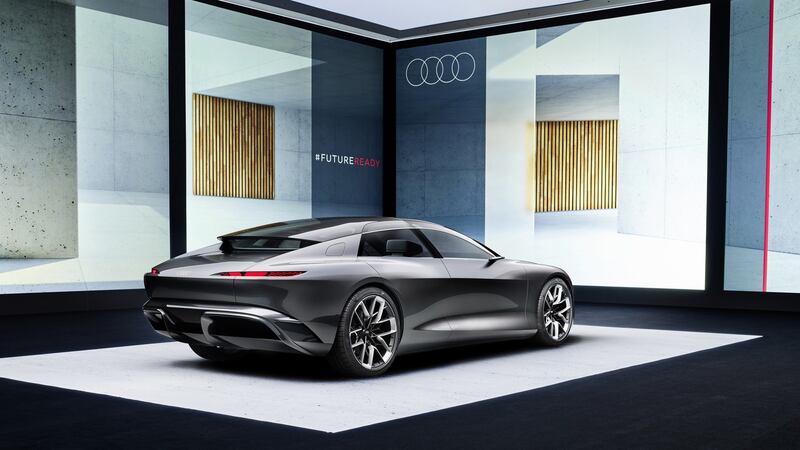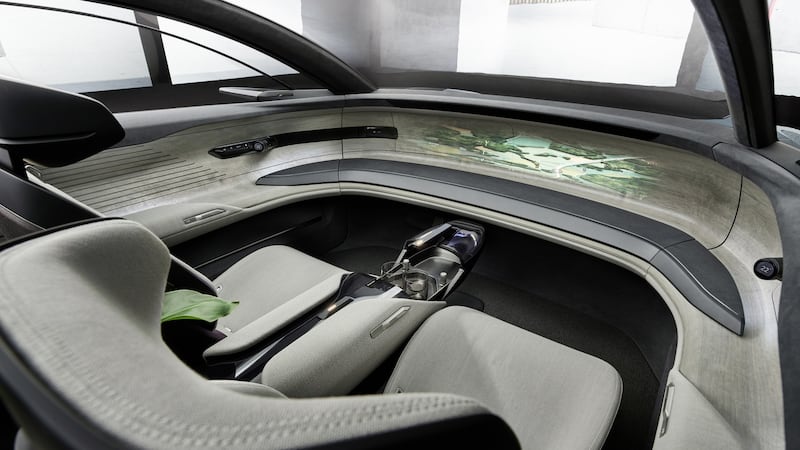We have, in a sense, been here before. Way back in 2001, Audi showed of its Avantissimo concept car - a large, luxurious machine, which instead of being a traditional three-box, four-doors-and-a-boot saloon was actually a big shooting brake estate. As well as previewing the general styling of the second-generation Audi A8, it was also supposedly to have been a big hint at an expansion of the A8 range to include other bodystyles.
Which never happened.
Likewise in 2009, the Audi Prologue Avant seemed to preview again a possible luxurious A8 estate. Which never happened (although the Prologue more or less unchanged became the current A6 Avant instead).
Now, the revolution has come around again and here we are with Audi showing off a concept car that purports to show the non-saloon future of the luxury car market.
The Audi Grand Sphere concept is long, low, sleek, and most definitely not a saloon. In fact, that long, teardrop-shaped rear end tapers almost to a sharp point.
New look
That grille isn’t a grille at all - the Grand Sphere is electric, so needs no big radiator intake - and instead it is the home for all of the Grand Sphere’s autonomous driving sensors.

At the rear, the buttresses that extend from the roof come almost all the way to the back of the bootlid. The Grand Sphere does actually have a separate boot - it is, in fact, a three-box saloon, but those buttresses and the slit-like rear screen give it the appearance of a 1960s mid-engined GT car. The car's designer, Amar Vaya, describes it as "a classical archetype in a modern interpretation." The four-ringed Audi badge on the back double-jobs as a centre brake light.
Inside, there are no controls, no steering wheel. The only physical controls, at first, are door-mounted switches for the seats and temperature controls, and even then you can use them without touching, just waving your hands around in front of gestures.
Self-driving?
Is the Grand Sphere designed to be entirely self-driving? Thankfully, no. There’s a little more theatre in here than it first seems. At the wave of a gesture controlling hand, a panel in the screen opens up and out whirrs a steering wheel, steering column, and integrated instrument display, so that the driver can take control as and when they want to.

The centre console also opens up when you switch from autonomous to driving mode, and even includes a neat little chilled water dispenser for when you fancy wetting your whistle on the go. Audi expects that hands-off, eyes-off Level 4 autonomy will be deployable on motorways and major roads towards the end of this decade.
How realistic a prospect is it, though? Up till now, luxury saloon buyers have been among the most conservative of customers, always preferring a ‘normal’ car shape. That may be changing, though.
Real car?
Audi's chief of design, Marc Lichte, has recently said that sales of traditional three-box luxury saloons are starting to slip, and so there may be an opportunity for something a little different. Added to which, Lichte has quietly admitted that attacking the mighty Mercedes-Benz S-Class head on hasn't worked - the Merc is still the dominant species in the sector - and so maybe trying something different might appeal to more customers.
How close is the Grand Sphere to production, though? That is up for debate for now. Audi brand manager Philip Gundert said at the car's reveal that: "The Audi Grand Sphere concept is definitely the one of our Sphere concept car trio that is the most similar, and comes closest to a large series project. You can see that the car has electric drive and is automated to Level 4, and we're already setting the stage for mass production of this car. By the middle of this decade, we hope to be able to present this to the public."
Audi’s skunkworks

The Grand Sphere is the first visible work from Audi's 'Project Artemis' skunkworks - a small, agile-thinking team within the company whose job is to envision the future of Audi's cars and the software that's so critical for them. Artemis is headed up by Alex Hitzinger, whose experience lies not in car making, but in the fast-moving (literally and figuratively) world of motorsports.
Hitzinger started his automotive career as a development engineer at Toyota Motorsport. At Ford-Cosworth, he was the youngest chief development engineer in Formula 1. Under his leadership, the first Formula 1 engine with an rpm limit of up to 20,000 rpm was created in 2006.
Having worked with Red Bull Technology, Hitzinger joined the Volkswagen Group for the first time and built up the highly successful motorsport team at Porsche that won the 24 Hours of Le Mans and the Endurance World Championship from 2015 to 2017. He then spent three years at Apple in Silicon Valley, where he set up and managed product development for autonomous vehicles. Hitzinger returned to the Volkswagen Group in 2019 to develop autonomous driving and the electric ID.Buzz project at VW Commercial Vehicles.
"I value Alex Hitzinger for his strengths in innovation and implementation. We need both qualities to make major technological advances," said Audi's board chief Markus Duesmann. "I am also relying on his expertise to integrate future achievements into new products together with the development departments of our major Group brands."















